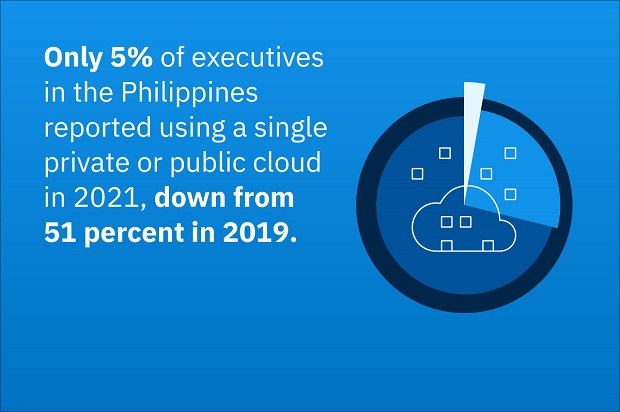According to the results of IBM’s new global study on cloud transformation there has been a drastic shift in business needs as, in alignment with global findings, only five percent of respondents in the Philippines reported using a single private or public cloud in 2021, down from 51 percent in 2019 – establishing hybrid cloud as the dominant IT architecture.

The global study, conducted by IBM Institute for Business Value (IBV) in cooperation with Oxford Economics, surveyed almost 7,200 C-suite executives across 28 industries and 47 countries, including the Philippines.
The findings indicated that the cloud market has entered the hybrid, multicloud era and concerns around vendor lock-in, security, compliance, and interoperability remain paramount.
The study found:
Cyber threats are at an all-time high
- Infrastructure complexity is creating cracked doors that cybercriminals are exploiting.
- Yet, surprisingly 49 percent of Filipino respondents did not indicate improving cybersecurity and reducing security risks are among their largest business and IT investments.
- At the same time, 80 percent said data security being embedded throughout the cloud architecture is important or extremely important, in most cases, to successful digital initiatives.

Companies are denouncing vendor lock-in
- Nearly 79 percent of respondents in the Philippines said workloads being completely portable with no vendor lock-in is important or extremely important to the success of their digital initiatives.
- 86 percent of Filipino respondents said vendor lock-in is a significant obstacle to improving business performance in most or all parts of their cloud estate, comparing to only 69 percent in globally.
Public cloud adoption is evolving towards industry clouds
- Nearly 70 percent of global respondents in the government and financial services sectors cited industry-related regulatory compliance as an obstacle to the business performance of their cloud estate.

“Not all cloud adoption journeys are created equal. In the beginning of their cloud journey, many companies experimented several different clouds. This complexity is creating cracked doors that cybercriminals are exploiting,” said Christine Ravelo, security leader for cloud, data & AI at IBM Philippines.
“This architecture can create a Frankenstein monster -or “Frankencloud” -riddled with complexity and disconnected piece parts put together, which can spiral out of control and open the company up to major security threats.”
She added: “The study’s findings made it clear that, for digital transformations to be successful, security, governance and compliance tools must run across multiple clouds and be embedded throughout hybrid cloud architectures.”

The study revealed that enterprises need to assess how they use the cloud in terms of adoption, velocity, migration, speed, and cost savings opportunity. Other recommendations include:
- Focus on security and privacy – determine where your critical workloads reside and scrutinize who and what has access to them. Regularly test that security controls and privacy policies are being adhered to, but also that improperly configured assets and software vulnerabilities are being promptly addressed.
- Ask which workloads should move to the cloud – take inventory of the IT environment to successfully determine which workloads and applications will yield the most value in the cloud and which are better suited to stay on-premises.
- Make data work for you – analyze workloads using AI driven tools and best practices to determine where and how to put them in the right place for the right reason.
- Set a tactical approach – address the technology trade-offs, such as selecting the best approach to modernize specific applications and manage important issues like security, governance, and disaster recovery.
- Determine the right team – put a cross-disciplinary team of people to work rethinking how your enterprise creates value for its customers.
Additional global findings from the 2021 report:
- By industry: Respondents in regulated industries, government (85 percent) and financial services (80 percent), cited governance and compliance tools being able to run across multiple clouds as important to success of digital initiative.
- By industry: Only 1 percent of respondents in the electronics, insurance, manufacturing, telco, transportation and travel industries, reported using a single private or public cloud in 2021.




